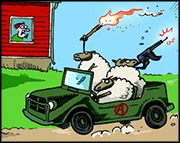|
Decoy Badger posted:At this point, what's the largest plane that it makes sense to run? A 747 can probably carry more passengers than the entire real-life population of these villages. Our 707 runs with full loads from Mangere Flying Club (The location of the real life Auckland Airport.) The rest of our airports don't support as many passengers. There are plenty of cities out there that would easily support multiple 707s if we can knock down enough buildings to build an airport. Glazius posted:Do you get a share of the proceeds from any building you build yourself, or is that abstracted out as the same share you'd get from successful transport of a third party? Once built, an industry is completely independent. The only advantage is that you can put it in a convenient place.
|
|
|
|

|
| # ? Apr 28, 2024 07:07 |
|
1967-1974: Tweaks and Hovercraft Locomotion Soundtrack - Mo' Station My second favourite song on the soundtrack Click here to name a vehicle! 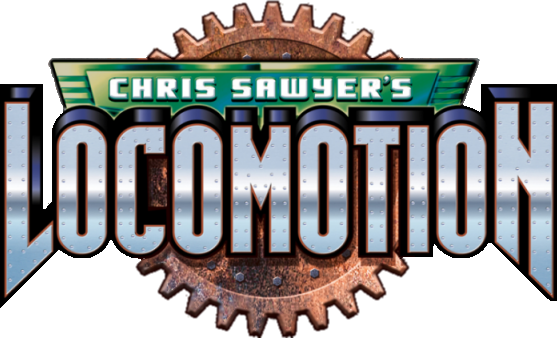 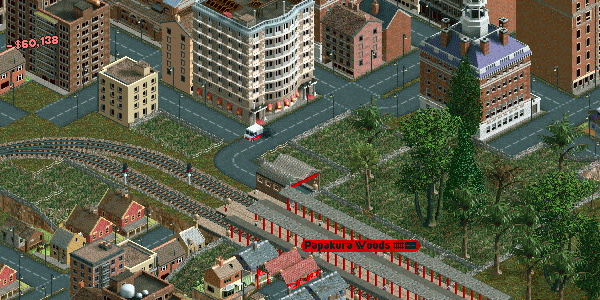 By this stage of the game, we're essentially in a cycle where every time we do something new, we then have to go back through the old stuff and replace or upgrade a series of vehicles. 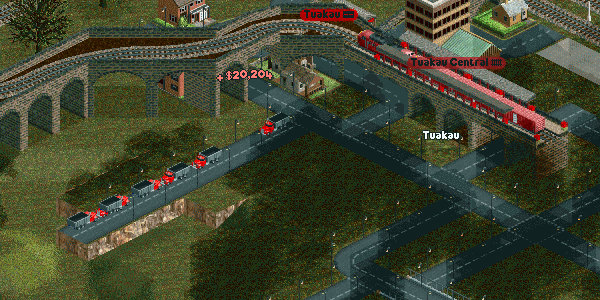 And of course one always has traffic jams to sort. This is typical: The town has built some extra road and now the trucks are trying to take the direct route. I resolved it by putting in extra waypoints that force them to turn left coming out of the station. 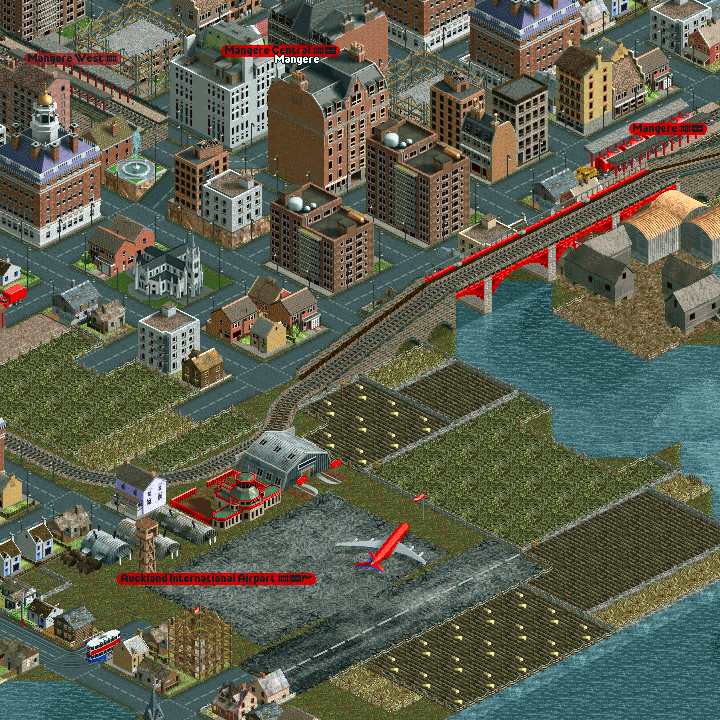 Mangere Flying Club gets a name more in keeping with it's importance. 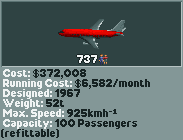 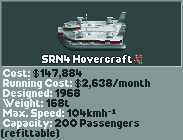  '67 is an important year for technical development, we're going to use all of these. We replace a couple of planes with 737s once the run in period is over, but we still keep a number of Viscounts to save running costs on low traffic routes. 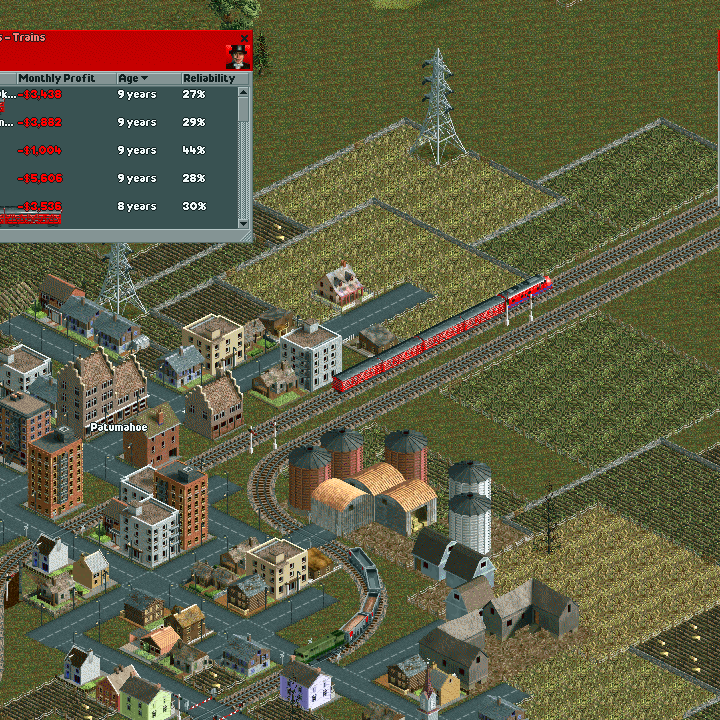 Railwise, we are upgrading a lot of trains to the larger wagon types. Often, they are less weight efficient, but they have higher maximum speeds.  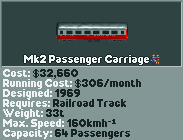 We aren't quite big enough for a 747 yet.   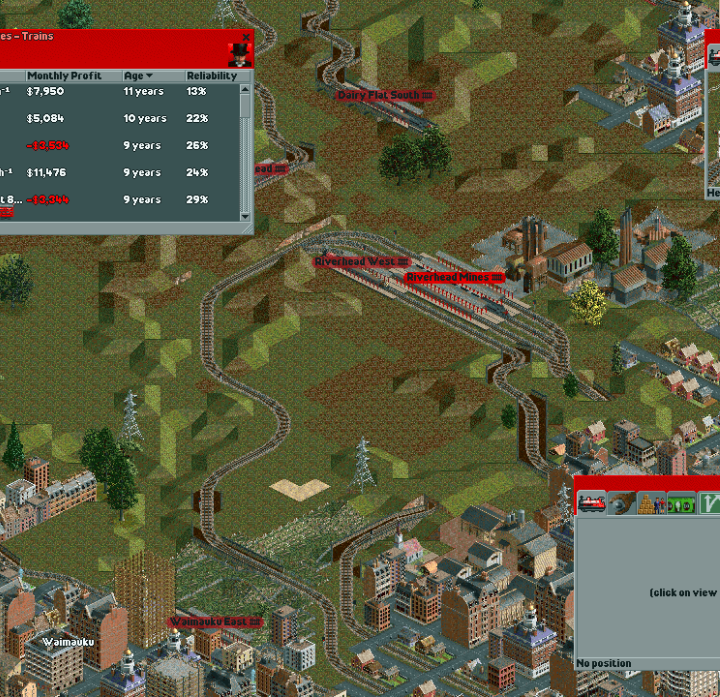 The forest at Riverhead closes down. Burgundy loses out as they have three rail lines serving it. This might give us more space to extend our lines up North. 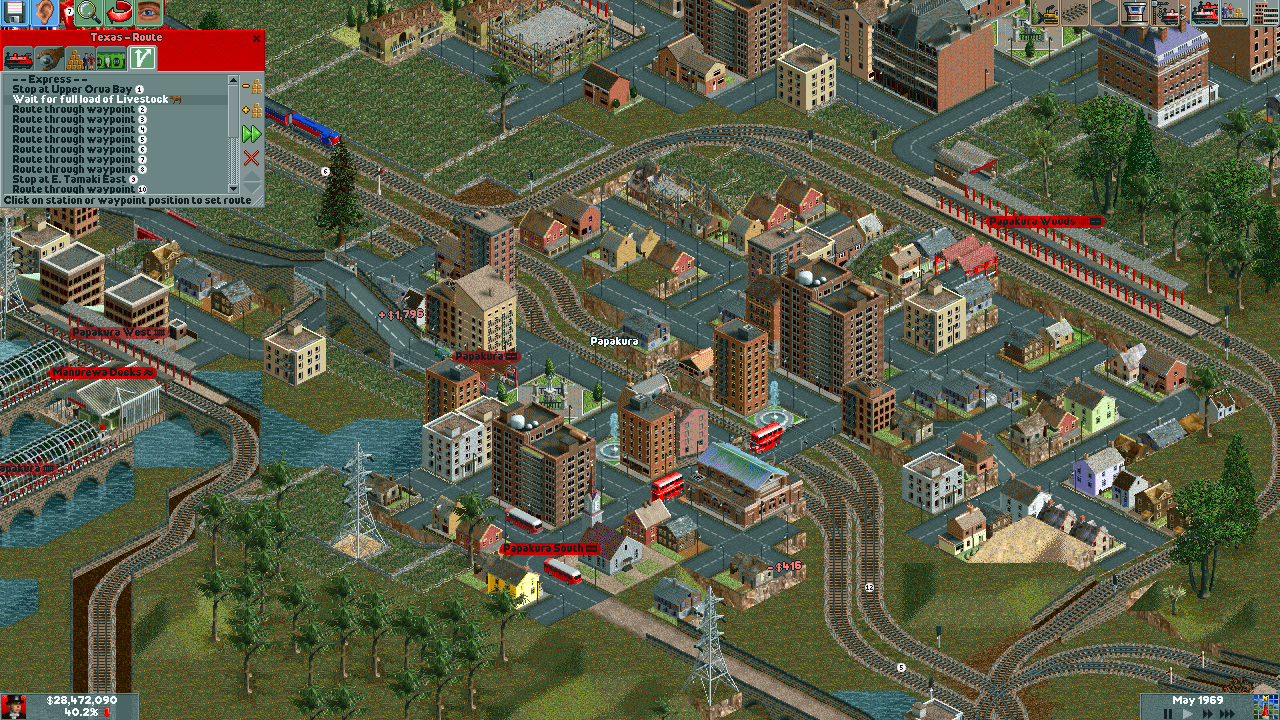 Another typical traffic operation, I reconnect the branch where the old Papakura printing works was and turn it into the southbound side of the main line. This eliminates the last bottleneck in the rail system. To make it work, I have to go through every train that routes through this area and remove the waypoints that used to tell them how to go through the bottleneck. 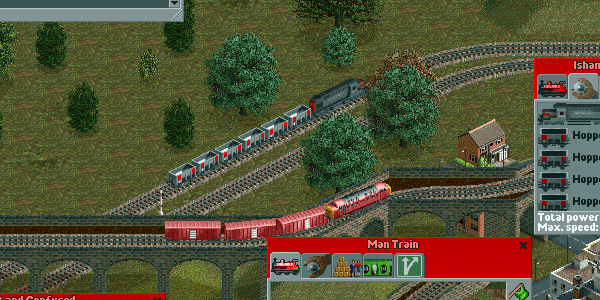 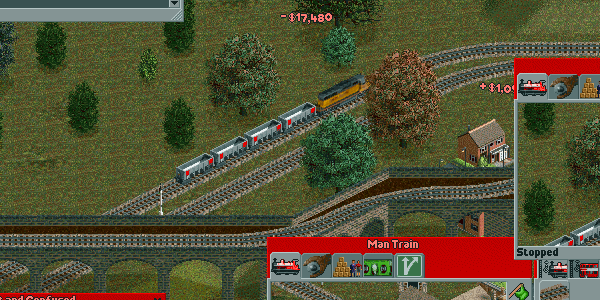 Typical 60s train upgrades: The heavy iron gets M420s or SD40s with lots of power and an increase in top speed. Class 20s are cheaper and lighter than the old shunters in the mid section of the line, except for Sweet Louise, still pulled by a 44ton. The last tank steamers are surprisingly hard to replace, as they are fast and cheap, but eventually the class 37 takes over, with a similar cheap running cost and high top speed, if not the same power. On our long range, lightweight livestock trains, the only replacement for the E8s is another E8, fast and powerful, while being reasonably economical. We're even more diverse now than we were in the steam era! 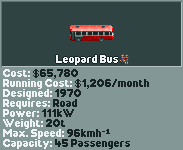 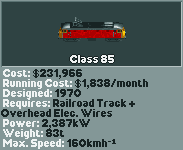 Electric traction finally makes it out. They have good stats, but just remember, this isn't Switzerland, models of electric locomotives will be few and far between. 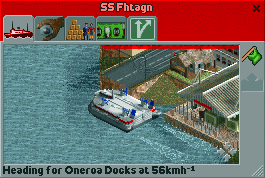 Our long range ferry services are replaced by Hovercraft and immediately start a water speed record cascade. 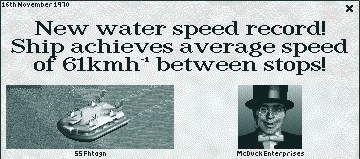    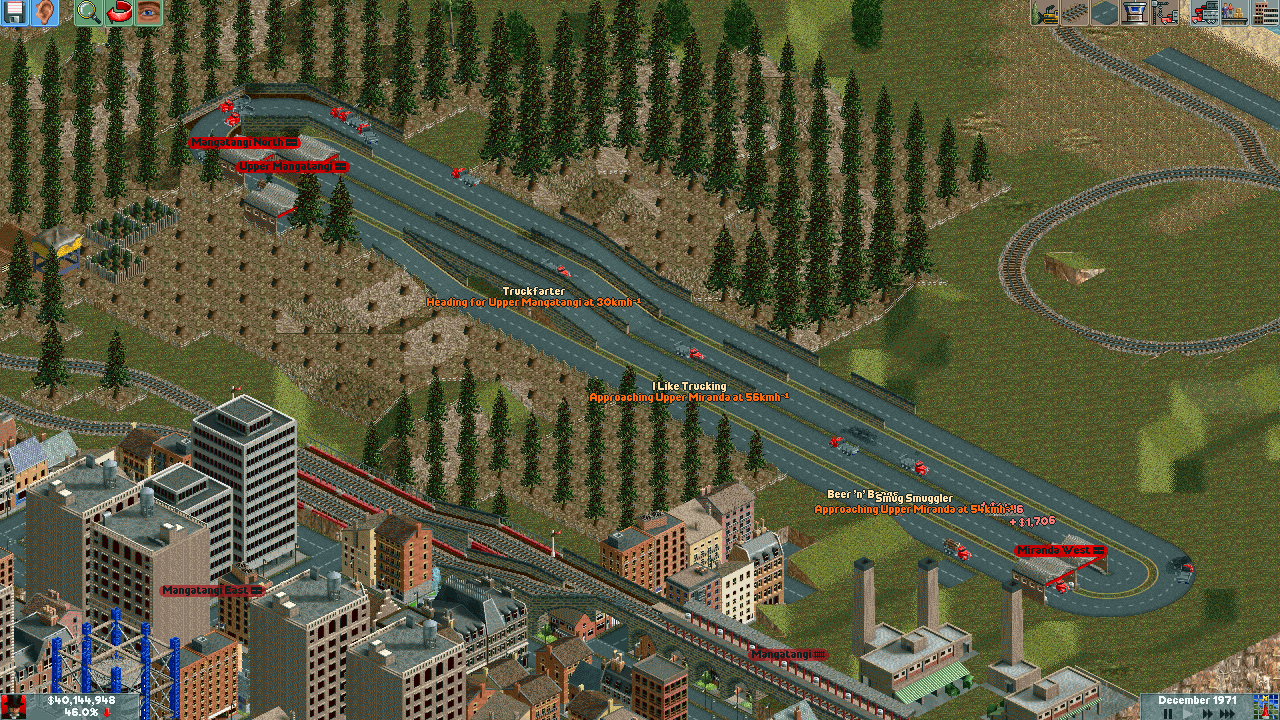 I feel like this is the logical conclusion for the trucking line featured in the last update. 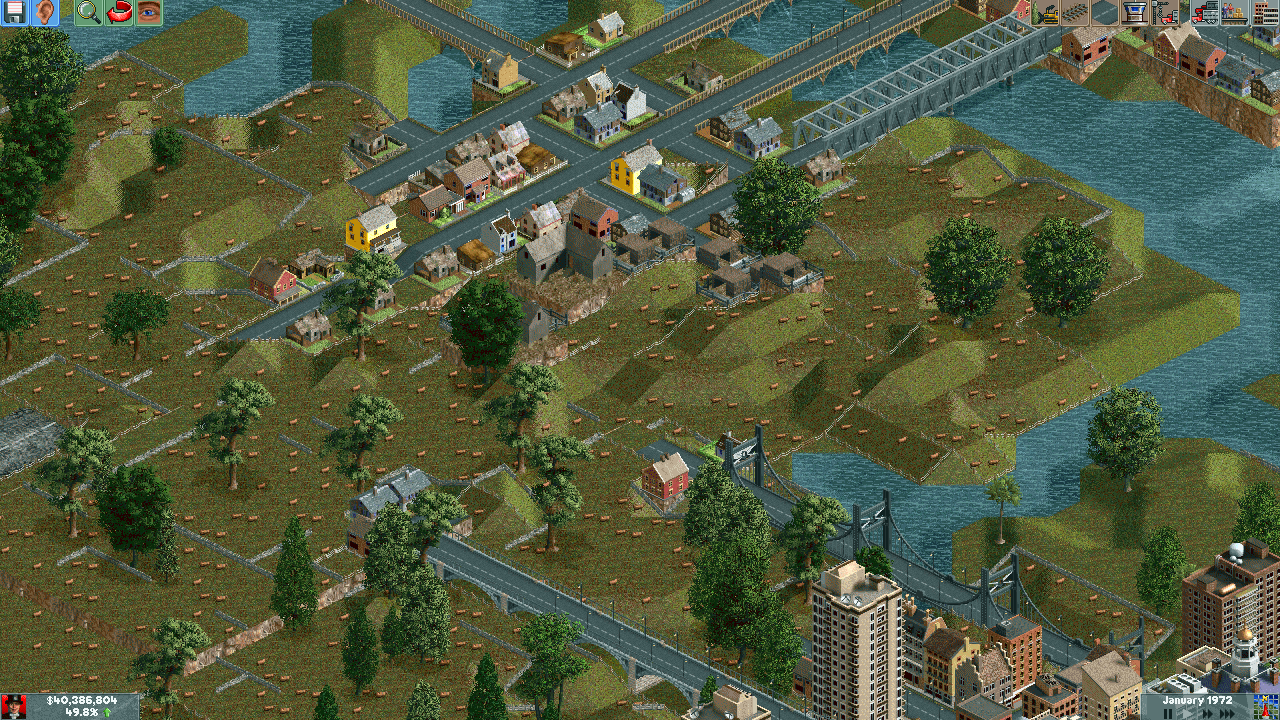 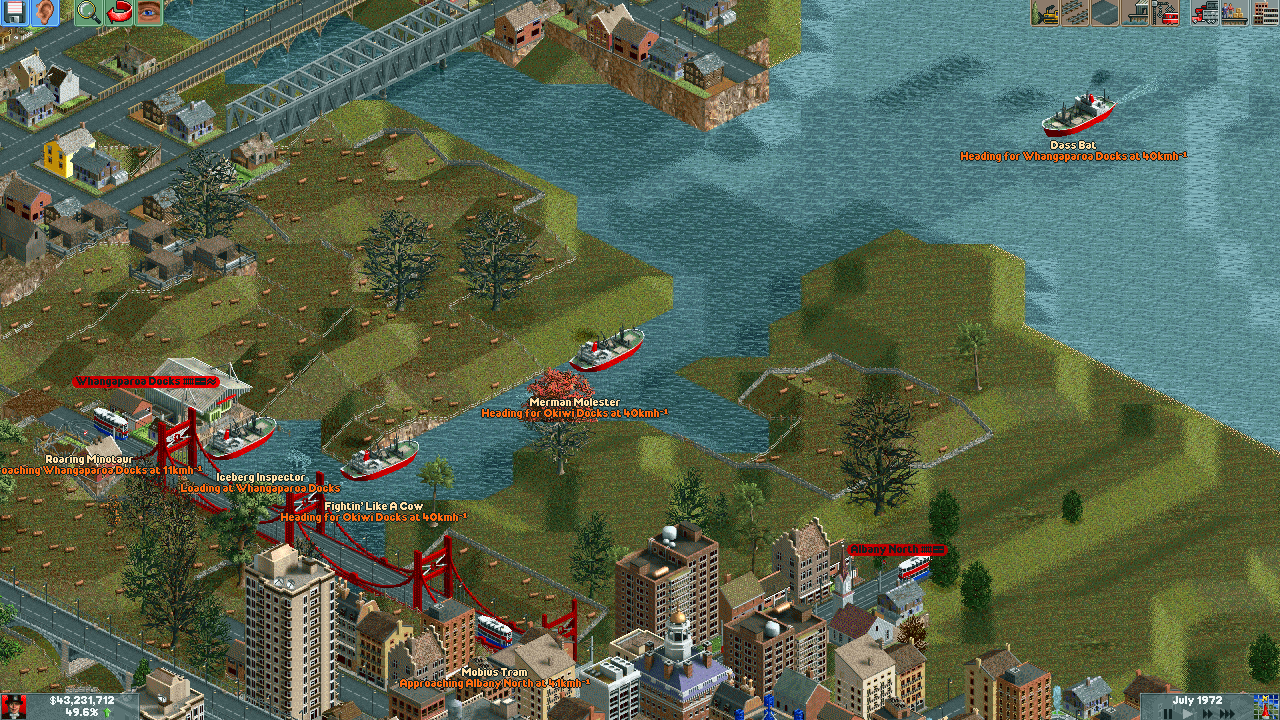 And it's not too hard to add new ship service out to the Great Barrier Island Food plant. 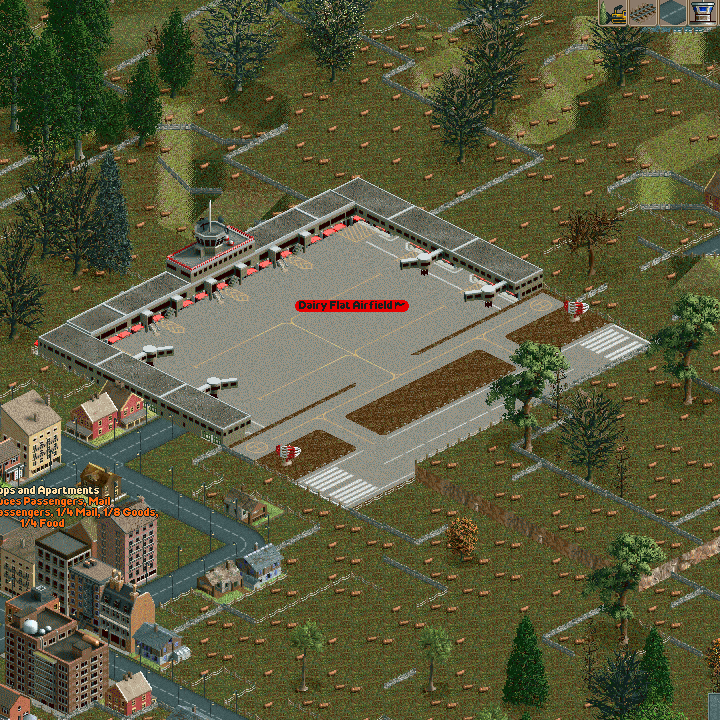 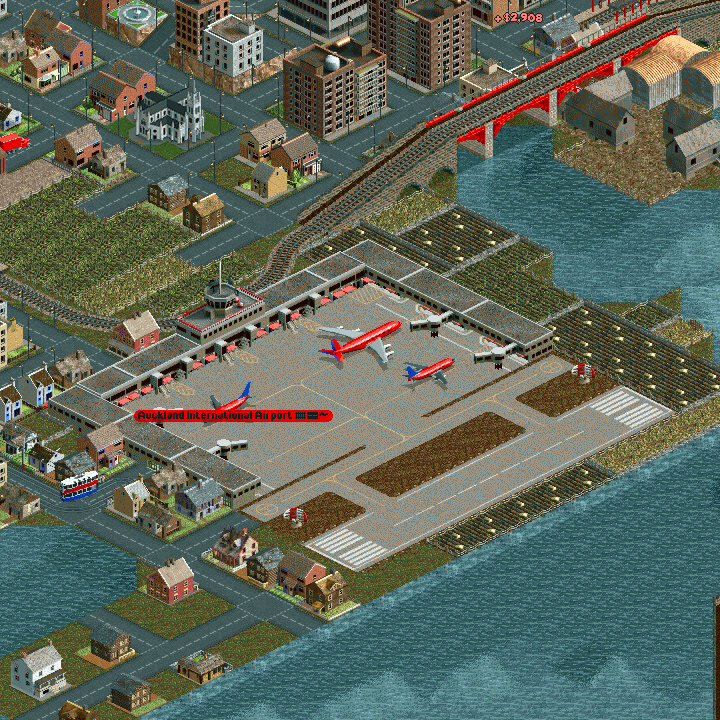 We upgrade two airports. This gives them more plane parking spots and they don't have to wait as long to fly away. Unfortunately the airport at Whenuapai is likely to be impossible to upgrade as is is hemmed in on three sides. 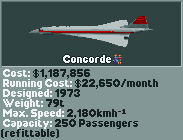 Concorde!  The brewery at Papatoetoe closes down. We've had a token truck serving it, should we build a new one? And now it's time for the News!    Our 707 is still breaking speed records.     Opened up immediately after the Papatoetoe brewery closed down. 
Jaguars! fucked around with this message at 22:43 on Mar 19, 2016 |
|
|
|
Aww my train, Louise, is still one of those funny/adorable looking shunters.
|
|
|
|
Sweet, get some concords up and running.
|
|
|
|
Galaga Galaxian posted:Aww my train, Louise, is still one of those funny/adorable looking shunters. Yeah, It's just ideal for the route because it's small size lets it fit and it's light weight lets it accelerate fast. It's hauling two large wagons instead of four small ones now. Poil posted:Sweet, get some concords up and running. For sure. I'm thinking a new airport down south = a long transit and helps us keep our speed record.
|
|
|
|
Those 737s look comically over-large, even for their new upgraded airports. Will 747s even fit on the runway?
|
|
|
|
Glazius posted:Those 737s look comically over-large, even for their new upgraded airports. Will 747s even fit on the runway? You should see the A380! As you'll soon see, the 747 is huge, the preview GIF is to scale with the rest of the screenshots. And what's with the Concorde taking 250 passengers? You'd be lucky to fit half that in there! Also I need an answer as to whether we save the Papatoetoe Brewery. Next answer wins.
|
|
|
|
Save the beer!
|
|
|
|
The Beer will be saved! I'll have to see about delivering more grain to it, It's in the worst part of the rail network.
|
|
|
|
I emerge from Midterms and Spring Break (And my college winning a great basketball game) in a drunken stupor. Time to teach y'all about airplanes, and a two-for-one special no less! Most refer to the 60's as the "Golden Age" of air travel, and they'd be pretty loving right. Tickets were finally becoming relatively affordable (I say relatively because the price was still five times what it is now. Tickets back then often costed 5% of a year's salary  ), and the planes were able to get more people and things to their destinations faster. It also acts as good point in time to describe the split in the thinking of aircraft designers: going fast or going big. Each have their own problems, and those problems get exponentially amplified the more in one direction you go. So, let's explore two of the most iconic aircraft of commercial aviation (note: each aircraft has a fuckton more history about the design and in some cases lengthy arguments about the usage of the letter e. But, you have lives so I'll skip that): ), and the planes were able to get more people and things to their destinations faster. It also acts as good point in time to describe the split in the thinking of aircraft designers: going fast or going big. Each have their own problems, and those problems get exponentially amplified the more in one direction you go. So, let's explore two of the most iconic aircraft of commercial aviation (note: each aircraft has a fuckton more history about the design and in some cases lengthy arguments about the usage of the letter e. But, you have lives so I'll skip that):Part 1: GOTTA GO FAST The idea of a supersonic transport (SST for short) had been around for about as long as we had been flying, since the concept of "go faster" is apparently human's instinct when it comes to travel. The first serious looks were given to the idea in the beginning of the 1950s, not long after Gen. Yeager took the X-1 past the sound barrier with two broken ribs and a broomstick (a story for another time). Supersonic fighter aircraft were becoming more and more commonplace, and the designers and engineers were starting to understand what effects supersonic flow had on designs. Welsh Engineer Morien Morgan had been commissioned to perform a study on SSTs in 1950, in which he determined one of the main sticking point would be the amazing amount of power and fuel required to propel a passenger plane beyond the speed of sound for long periods of time. He said it would "result in some horribly large aeroplanes," and considered the idea unfeasible. Six years later Morgan (under directive by the Crown) put together a new committee called the Supersonic Transport Advisory Committee to figure out how the gently caress to make these aircraft feasible. Their goal was to make an aircraft that was economically comparable to its subsonic counterparts (assuming that the massive fuel costs would be counteracted by a greater number of flights in a given time), fly across the atlantic at Mach 2, carry 150 passengers, and cost about 75-90 million pounds. Contracts were awarded in 1959 to the British Aircraft Corporation (comprising of several UK aircraft companies), who in turn started discussing the idea with and Sud (later named Aerospatial). In 1960 the French (who had SST ideas of their own) joined up with BAC via government-owned Aerospatial and the SST aircraft was dubbed Concorde, meaning unity. Two prototypes were built in 1969 -- one British, one French -- and Concord went on a world tour to demonstrate its capabilities and sell aircraft. Before the wheels had even left the ground, BAC and Aerospatial had 74 orders from 16 airlines. Here's where I have to mention some problems of flying past the sound barrier. I mentioned a big one at the beginning: it's loving expensive to maintain, fuel, and design. On top of that, poo poo gets hot at Mach 2, so you have to account for thermal expansion and other fun heat things (Concorde grew 6 inches during flight and had refrigerated windows so passengers didn't burn their hands on the 100C skin). The engines were massively loud, and the sonic booms were feared and despised. Most everyone thought fought Concorde landing at airports near their houses, and backed up their concerns with strange claims (deafening their children, giving them x disease, and even disrupting someone's rhythm method and getting their wife pregnant). There's one last big gleaming issue that helped kill the idea of SST, more on that later though.  Concorde gets loving hot Concorde entered service in 1976 with London-Bahrain, Paris-Rio, and Paris-Caracas routes. US Congress banned the Concorde due to protests over noise concerns, but made special exception for JFK and Washington-Dulles airports. Tickets were ungodly expensive (about $12,000 round-trip) and even then the airlines were taking heavy losses on the flights. They tried to make the price seem more appealing by offering lavish services such as a menu of caviar, lobster, champagne and Cuban cigars. Moreover, an SST was seen as a gimmick and airlines didn't want one even if it was profitable. And there lies the biggest problem: no one WANTED the loving thing. Airlines cancelled their orders and put BAC/AS up poo poo creek with no paddle and no money. Post-9/11 air travel fears, rising maintenance costs, and other better rival aircraft all tightened the noose more and more on the aging aircraft, until it was finally retired in 2003. Only 14 aircraft ever flew commercially, and all but two are either under restoration or on display in museums. Private rich dudes are trying to bring the aircraft back into charter service, but private rich people have more dollars than sense. https://www.youtube.com/watch?v=YeEB2Lxbfa4 A flight from inside the Concorde, featuring a very informative pilot Part 2: Let the Queen Fly, or Seattle Fall Across the pond, Boeing was in dire straits. The company that was one of the biggest employers in the Seattle-Tacoma area had just lost out on a big heavy lifting contract for the USAF to Lockheed's C-5 Galaxy, and rumors were abound that Congress was cancelling their rival SST (aptly named the Boeing SST) before prototypes could even be built. Orders on their airliners were falling, and many thought the company may not be around much longer at this rate. Not to be counted out yet, Boeing bet their company on an idea: Make their heavy lifter an airliner. Changes were made, seats were added, and a full-length double deck was turned a half-length one to create a distinctive top-bulge. By mid-1966, the nicknamed "Queen of the Skies" began to take shape, and airlines liked what they saw. Pan-Am bought one, with a delivery date by the end of 1969. Boeing had to finish designs of an entirely new aircraft, test it, certify it, and deliver it all in 28 months. I think this is the definition of "crunch time." The prototype was absolutely massive: 60 meters wide, 70 meters long, weighing more than 162 metric tons empty and capable of taking 480 passengers intercontinental in luxury. The plane was both wider and longer than the Wright's first flight at Kitty Hawk. The aircraft was so big, in fact, a new 100 acre building had to be built to accommodate an assembly line for these aircraft. But, there wasn't enough time to finish the building and build the testing vehicles, so the latter were built before a roof was on the former. Money was running low and employees were working 80 hour weeks to finish the project. By the end of September 1968 the first prototype rolled out on display to the public. 26 airliners placed orders, and the airliner entered service in January 1970. Orders were coming in, and maybe in a few years the project will break even. Boeing had even begun to recover some of it's $2B dollar debt it accrued from the project. The gamble looked like it had worked. 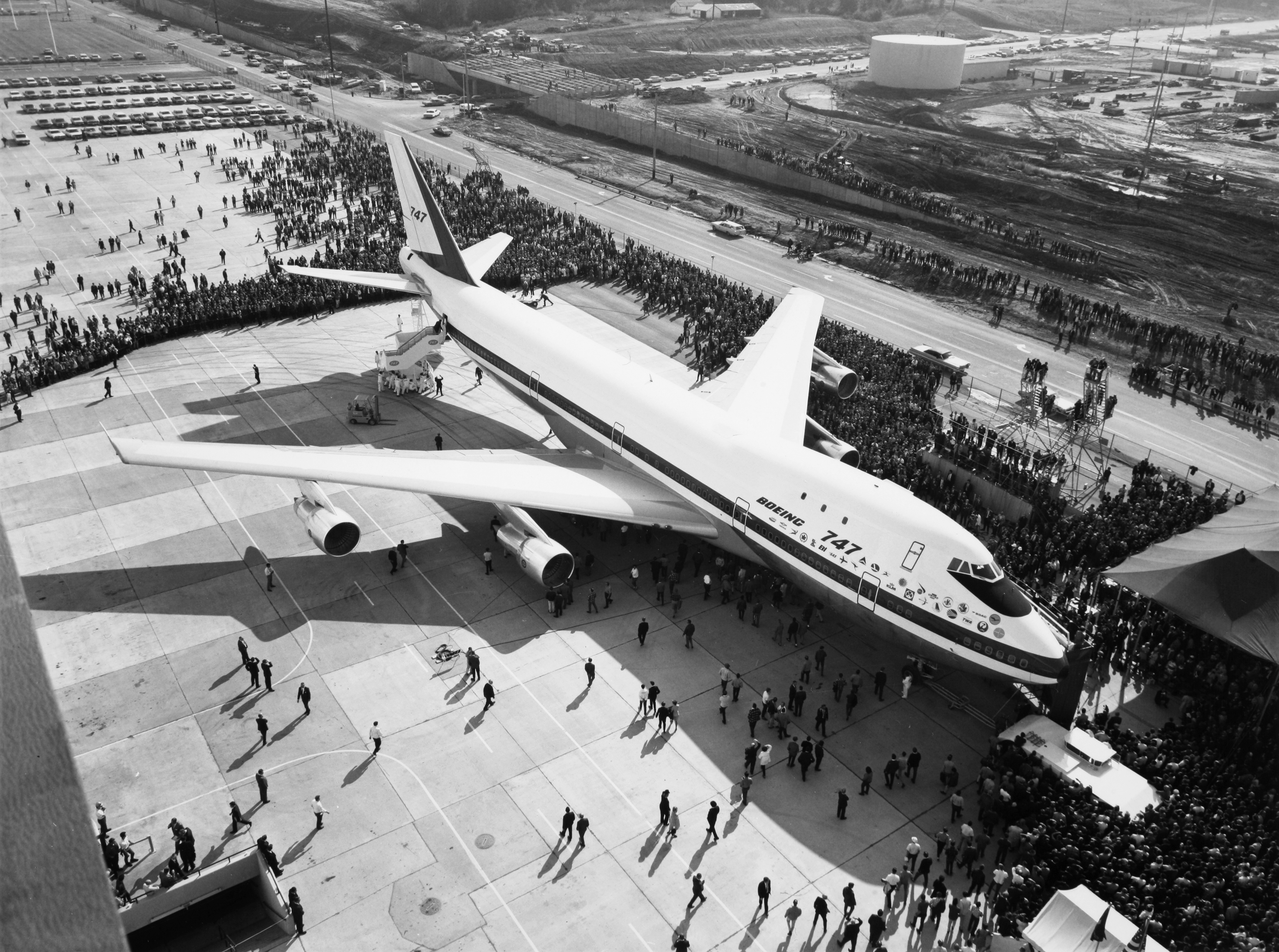 The first 747 on display But of course something had to gently caress up. In 1970 there was a massive recession and the aviation industry came down with it. From September 1970 to March 1972 there were 2 orders placed for a 747. The SST was cancelled for realsies in 1971, cutting Boeing employees from 100,000 to 32,000. The unemployment rate in Seattle was double what it was elsewhere in the country. The situation looked so dire someone bought a billboard on the outskirts of town by the Everett factory: "Will the last person leaving Seattle turn out the lights"  Engine deficiencies had crippled deliveries of the new orders, but Boeing persisted. It modified the design, giving it better economy and more carrying capacity. As the recession ended, more and more people began to take to the skies and the order poured in. Contracts were given from NASA, the DoD, The Air Force (including the two aircraft used for carrying the President), and any rich dude with $350M. Seattle bounced back, and along with it Boeing. 1,500 aircraft have been delivered to date across 8 major variants. The 747 is considered to be one of the biggest airliner successes in recent history. The gamble finally, truly paid off. So there you have it. Two very different aircraft, each at opposite ends of the spectrum. One was seen as the future and projected to be a success, the other an underdog from a dying company with massive carrying capacity. Hopefully you guys don't mind me writing 1500 words And yes, this was all a roundabout way to say "747's over Concordes, Jaguars!" Spaced God fucked around with this message at 03:16 on May 23, 2016 |
|
|
|
Damnit, now I want to play Aerobiz or something.
|
|
|
|
Spaced God posted:The engines were massively loud, and the sonic booms were feared and despised, The general public and especially those around airports found them annoying, including claims that they were deafening their children, giving them x disease, and even one claim that a Concorde disrupted someone's rhythm method and got his wife pregnant. According to an interview he gave when the Concordes were retired, when the head of the British half of the project was first shown the specifications his reaction was to say that if they needed transatlantic communications that fast then the entire budget should be invested in videoconferencing instead. And when we talk about fear of sonic booms, we mean massive, hilarious fear. Part of my work involves sifting through old 1960s/70s land documents and leases, and a common clause in tens of thousands of commercial and residential agreements back then was a ban on any creation of sonic booms! Y'know. For all those supersonic private flying cars we were all gonna have by the year 2000 
|
|
|
|
Loxbourne posted:And when we talk about fear of sonic booms, we mean massive, hilarious fear. Part of my work involves sifting through old 1960s/70s land documents and leases, and a common clause in tens of thousands of commercial and residential agreements back then was a ban on any creation of sonic booms! My favorite thing about Concorde and noise abatement is that there were always sound measuring equipment every so many miles from the runway, and it would trigger an alarm to yell at/fine an operator if their aircraft exceeded noise abatement limits. Because Concorde has four afterburning turbojets (because Concorde), they couldn't fly normal departures for fear of tripping the alarms. Instead what they did was learn where the sensors were placed and turn away from them in such a way that the Doppler effect lessened the noise and didn't trip the sensor. Also the whole "these things are gonna put a hole in the o-zone layer with their sonic booms and jet fuel" concern while people were going to town on their CFCs
|
|
|
|
I love these technical/historical info interludes.
|
|
|
|
PurpleXVI posted:I love these technical/historical info interludes. Thanks!  I know I really dig the train stuff Paul talks about. My fear is that I get too long winded and the interludes take up more than the actual updates. You guys should also let me know if you prefer the history or the design decisions and stuff. I know a stupid amount about both but I can't tell what's more interesting for the thread. I know I really dig the train stuff Paul talks about. My fear is that I get too long winded and the interludes take up more than the actual updates. You guys should also let me know if you prefer the history or the design decisions and stuff. I know a stupid amount about both but I can't tell what's more interesting for the thread.Also, if you want stuff written by someone better at explaining poo poo than me, the OP of the Aeronautical Insanity thread has a bunch of little vignettes
|
|
|
|
I didn't realize Concordes were banned in all but two US airports. I always thought it was just restricted to ocean crossing flights. Man, now suddenly one of my favorite Miami Vice episodes is all wrong. It features a terrorist plot to shoot down a Concorde landing in Miami with stolen stinger missiles.
|
|
|
|
Galaga Galaxian posted:I didn't realize Concordes were banned in all but two US airports. I always thought it was just restricted to ocean crossing flights. Oops! I made a mistake. Concorde also had an IAD-DFW (subsonic) route for some loving reason under Braniff up until May 1980. Despite being only scheduled in 3 airports, they made visits to Florida, including Miami in 87. Maybe they could've had a plan for that visit?  Anyways I'm gonna stop replying to every planepost like a dumb nerd. Maybe next ~episode~ will be about the De Havilland Comet, since Jaguars! unlocked that a few updates ago and that plane both revolutionized the industry and killed a fuckton of people because squares 
|
|
|
|
Spaced God posted:Oops! I made a mistake. Concorde also had an IAD-DFW (subsonic) route for some loving reason under Braniff up until May 1980. Despite being only scheduled in 3 airports, they made visits to Florida, including Miami in 87. Maybe they could've had a plan for that visit? Hey now. This thread is about enjoying Foaming in all its shapes and sizes!
|
|
|
|
All hail the A380, crusher of puny pixel-airports.
|
|
|
|
Veloxyll posted:Hey now. This thread is about enjoying Foaming in all its shapes and sizes! I respect machinery with a body count - proves it has live experience! Wonder of Jaguars! included the L-1011 as part of his vehicle selection...
|
|
|
|
Psychotic Weasel posted:I respect machinery with a body count - proves it has live experience! It's not part of the vanilla selection. The first thing I'm doing when I finish this will be to download that Aircraft pack I found and find some more oddball aircraft. Thanks for the words, Spaced God, and glad your team went well, mine didn't.  We have class leaders for both aircraft as of the other night, haven't got any further than that. We have class leaders for both aircraft as of the other night, haven't got any further than that.I visited the Boeing plant in 1999, we saw the 777 plant instead of the 747s and while the tour guide was right when she said that we were lucky to see the area where the best and brightest focused their efforts, I think everyone couldn't help but be a little disappointed at missing out on seeing the jumbos.
|
|
|
|
1974-1980: Back to Trains Locomotion Soundtrack - Never Stop 'Til You Get There My favourite song of the soundtrack, It harks back to the funk heavy soundtrack of the older entries of the series. Click here to name a vehicle!  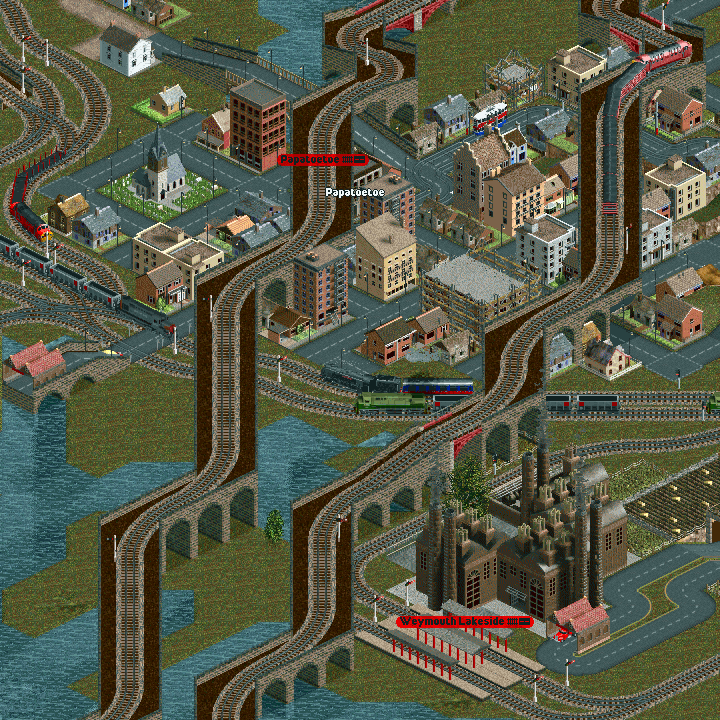 As ever, we start by clearing some jams. Notice how it's always this bit? It's a bastard of a sector where any delay causes trafic to queue across junctions, escalating to gridlock. I'm too much of a coward to redo it without demolishing half the town. 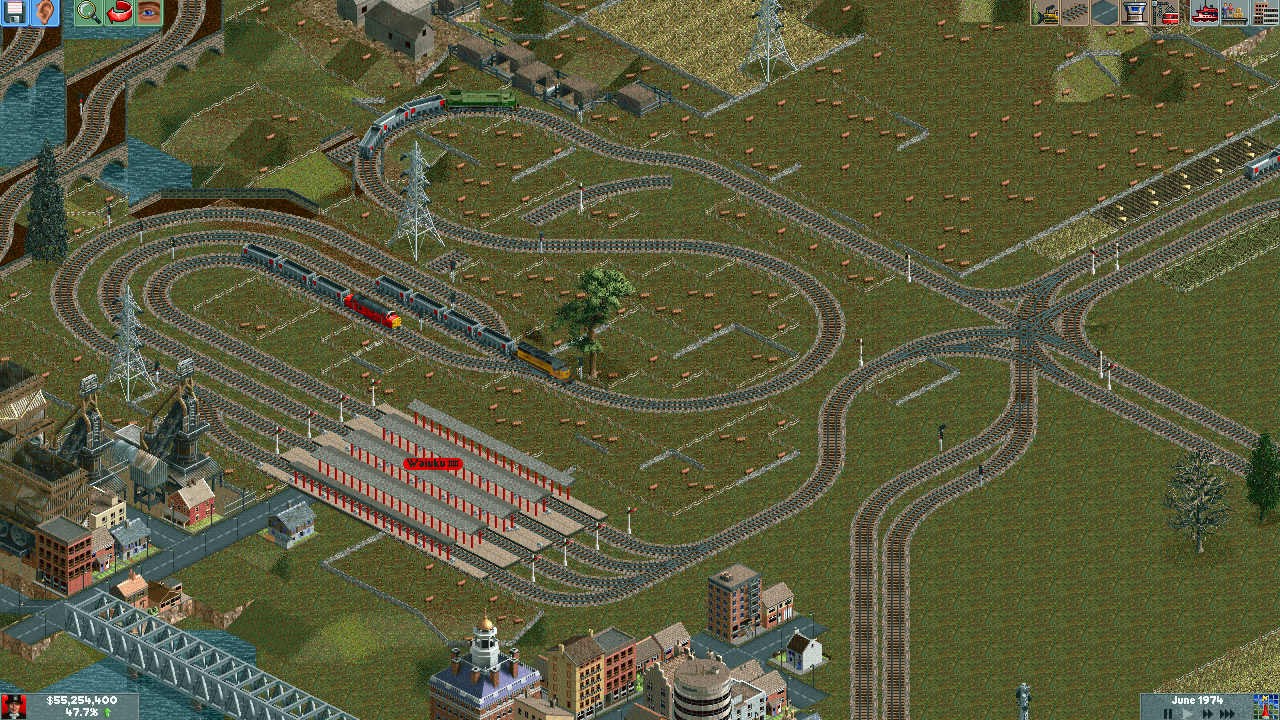 The big station at the Glenbrook steel mill has a capacity of nine trains, but occasionally that's not enough to hold everything that wants to go there, so we have to find a way of storing more trains. This is the solution. 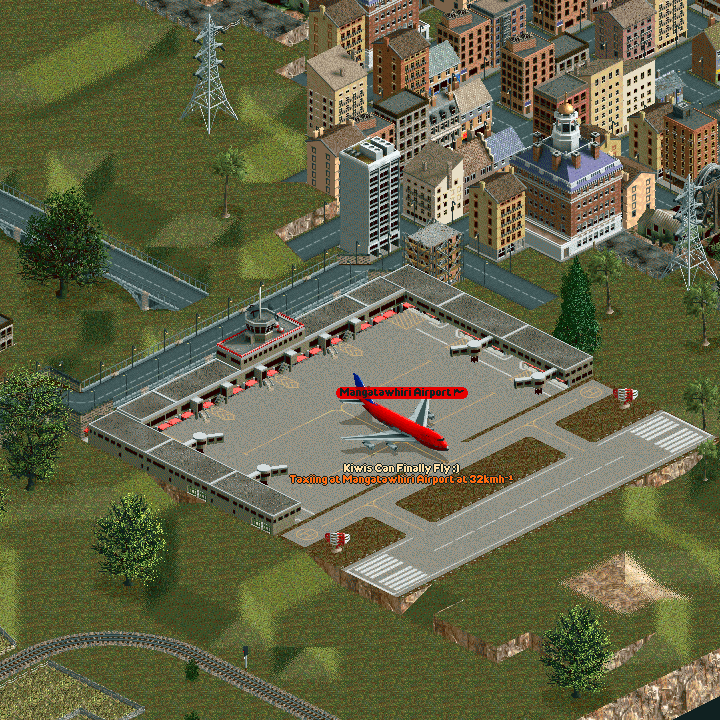 The heavy iron takes to the air at the new metropolitan airport at Mangatawhiri.  Closely followed by the this graceful delta. Both are bound for the Dairy Flat Airfield, clear across the map. 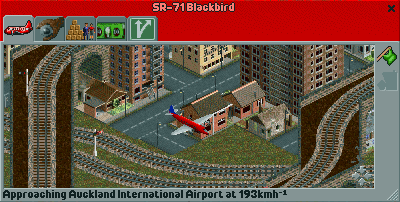 On a more prosaic note, we incorporate our first airmail service between Mangatawhiri and Auckland using the trusty Viscount.  We restore the Papatoetoe brewery to operation.  We haven't laid any new rail since the 60s or earlier, so Scrooge decides to use the Eastern branch more effectively. He decides to build a new spur to collect grain from the hills outside Clevedon and bring it to the Food plant in East Tamaki. 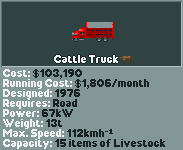 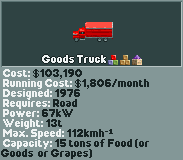 In the meantime, a few more fourth generation trucks appear. 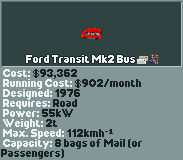 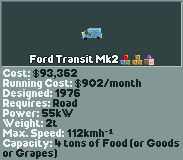 As well as the Mk 2 Transit van. While it doesn't haul more, it's more powerful and has a higher top speed.  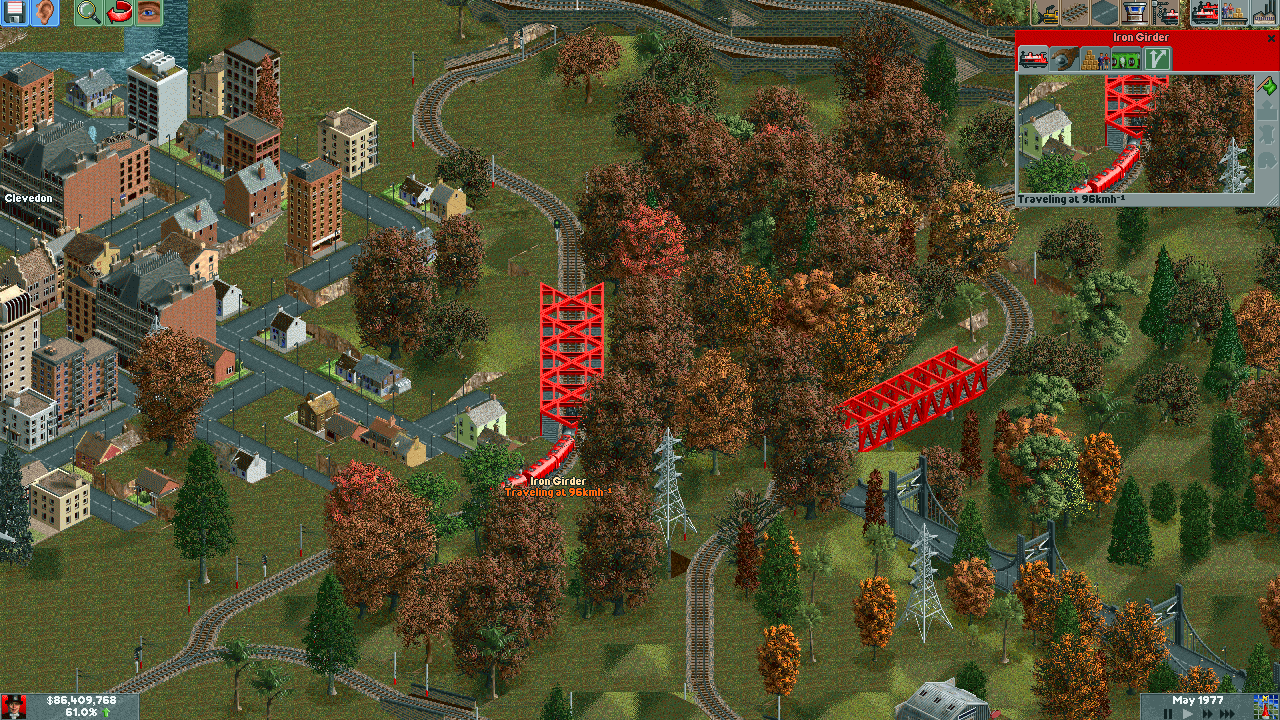 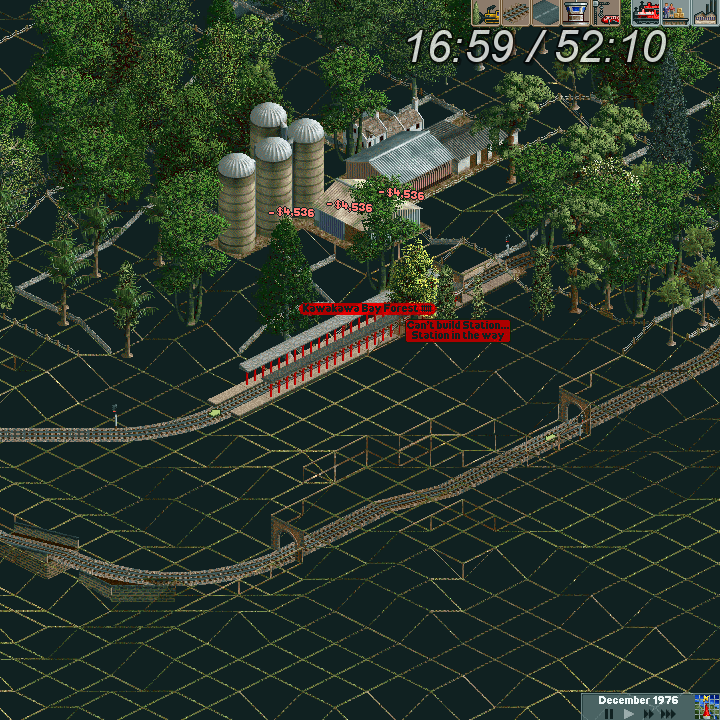 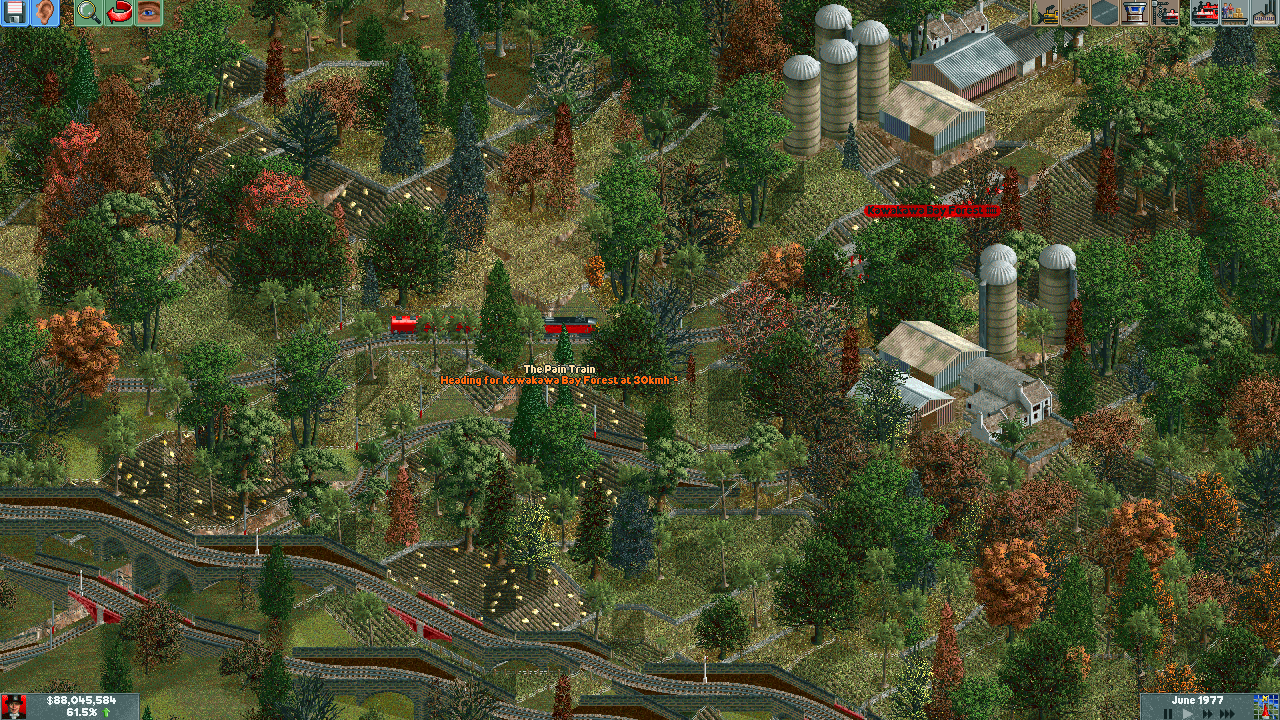 We decide to go electric on the new line, getting the benefit of high power and low running cost. The electric wires also prevent them from running off to the other side of the rail network. 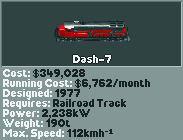  Our current flatbeds still have a few years of life in them, but now they have a replacement. 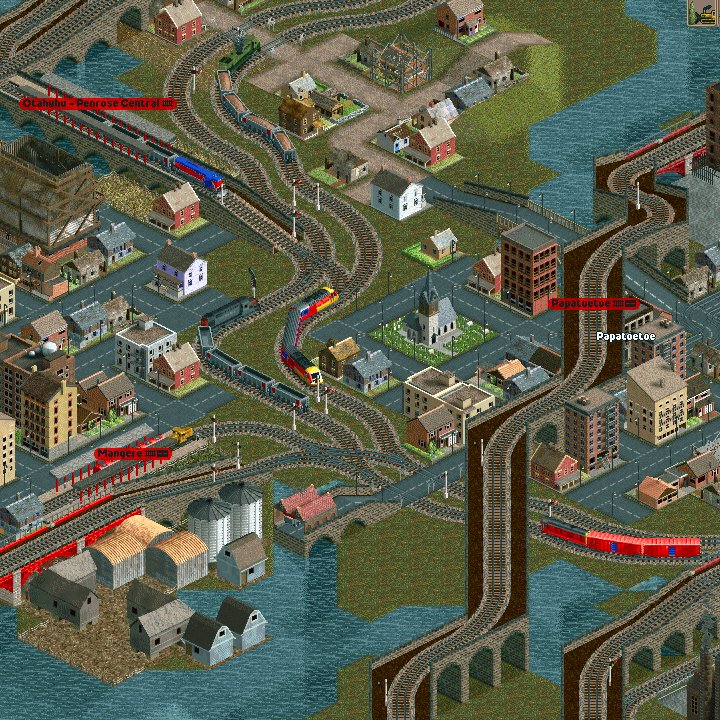 This area has been a pain in the side for years. It's finally time to do something about it. We're going to bypass the whole thing. 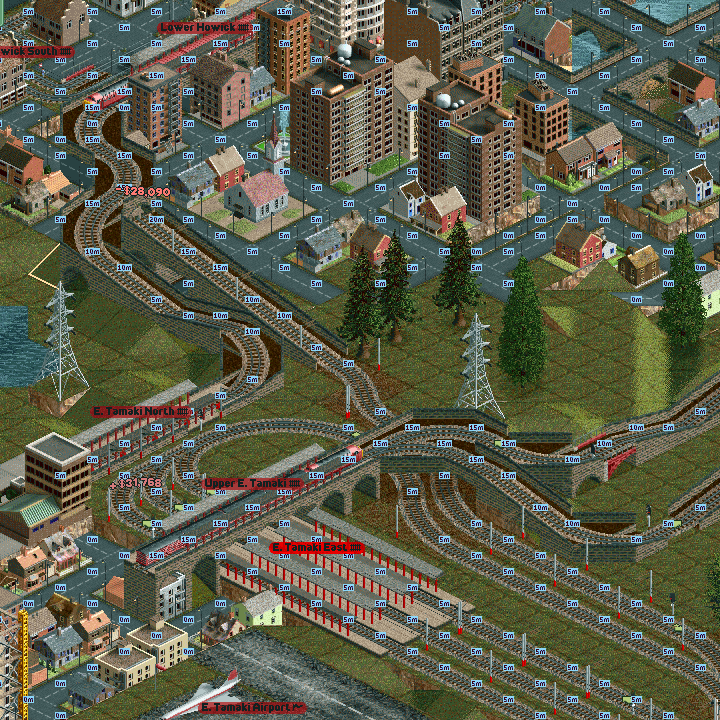 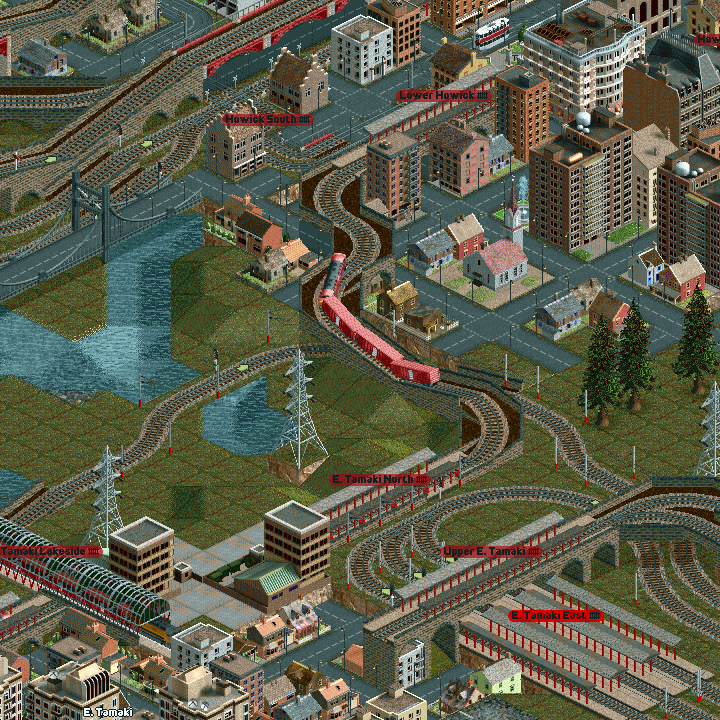 Turns out you can't out-rollercoaster Burgundy, we go under instead. 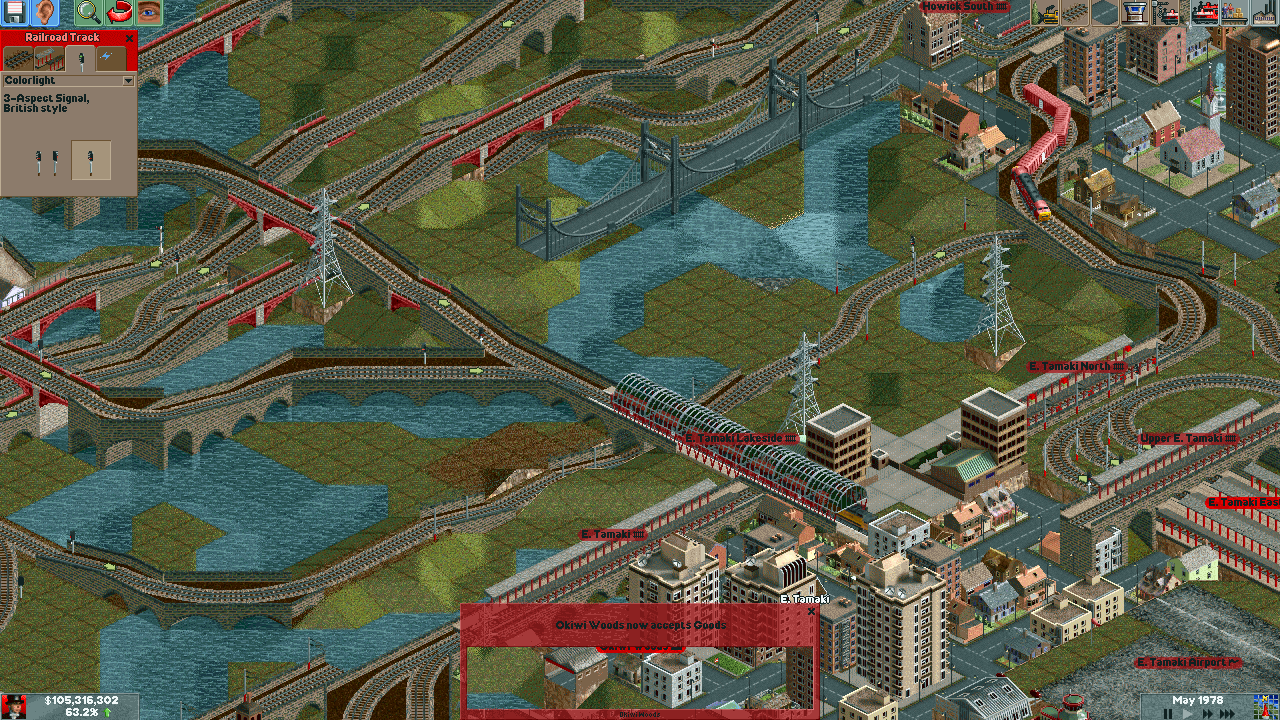 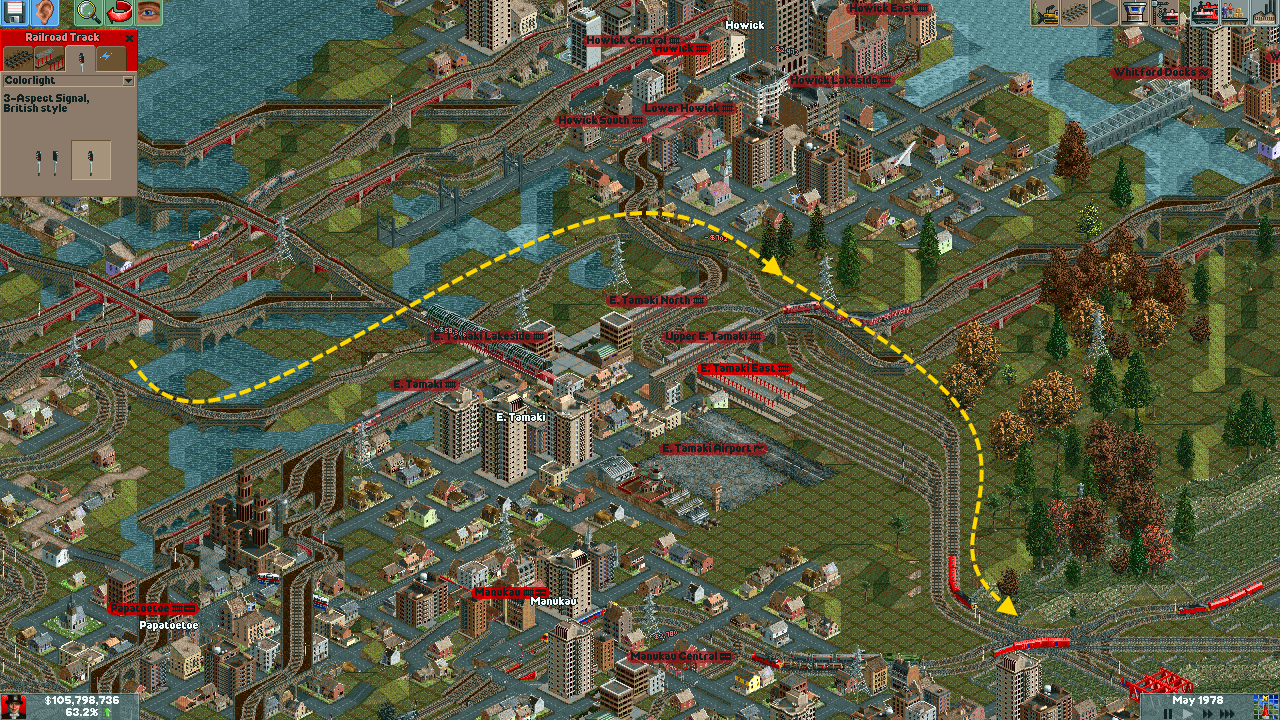 Southbound trains will no longer choke up the area, hopefully the current setup can handle the reduced traffic. 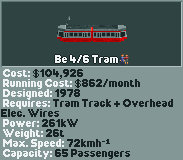 The gentle evolution of light rail continues. 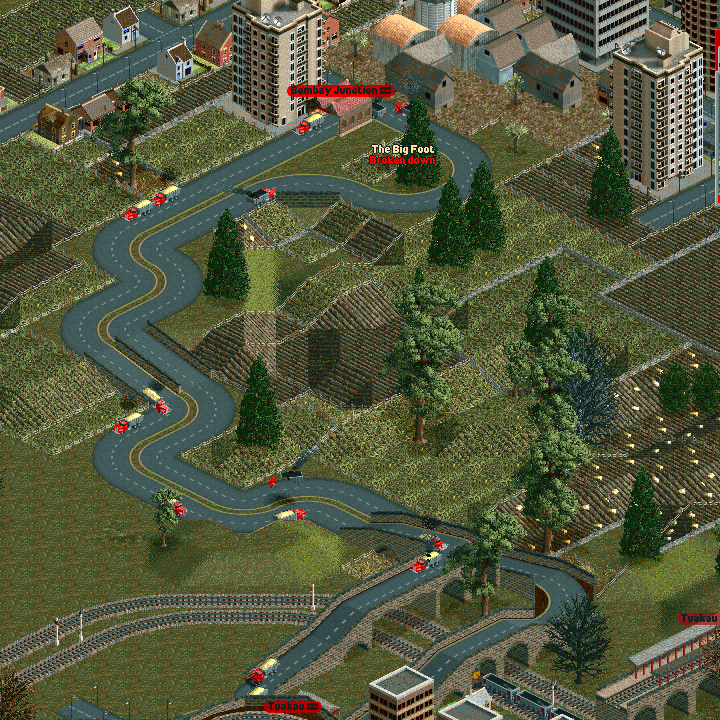 These hopper trucks have had to wait for replacement and they're totally worn out. The old ones carry 15t, the new ones an impressive 28t. 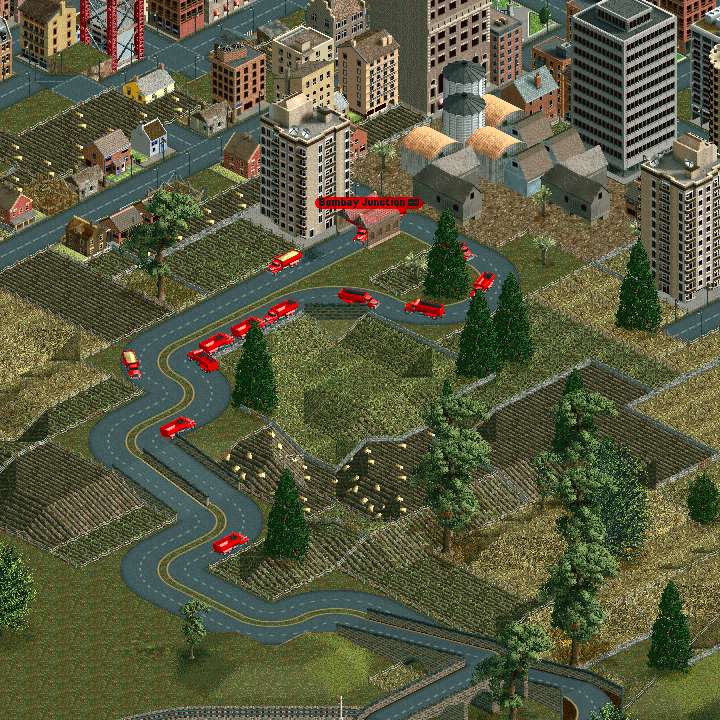  With replacement done, a strange thing happens. We've saturated the line and now the trucks have to wait for enough grain to be produced. It's a far cry from the days when dozens of trucks took about 10% of the farm's production. 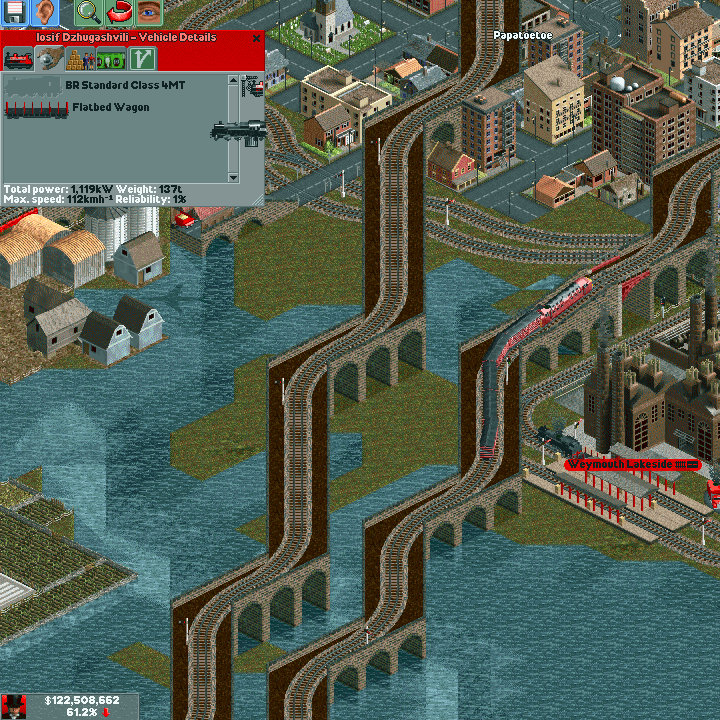 The last of our steam engines is replaced by one of the ubiquitous class 37s. And now it's time for the News!  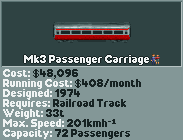 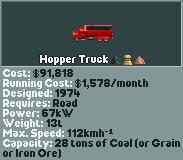 A very useful upgrade, considering how many of these we have. 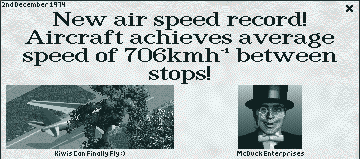 The Jumbo's maiden flight is a record breaker!  Neat, we can finally try some fast passenger service! 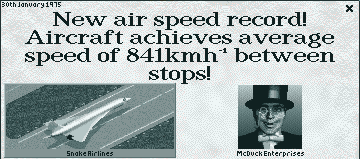 Of course, it doesn't stand for long!  Burgundy is getting heavily into the mail business now as well. 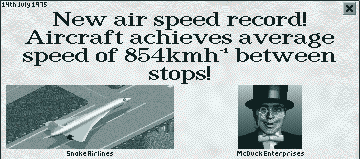    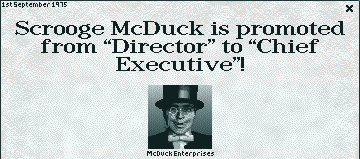 We've seen a few of these recently. We're actually catching up slightly on Eggburt and Burgundy Transport, although they're still way ahead by company value.  Auckland Int'l was going through one of it's don't accept mail or food stages, so it took a while for the new airmail to work properly. 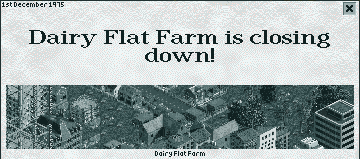 It closed when we rebuilt the Papatoetoe brewery. we've probably hit the maximum industry limit.    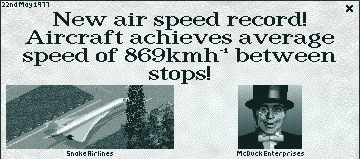 Air speed record continues upward.   I think most of these are down to Burgundy's buying class 125s, since they carry a small amount of mail in the power cars. 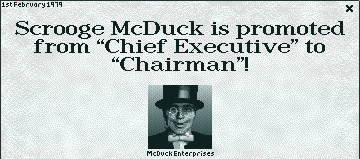 We're finally catching up on Eggburt and Burgundy transport in company rating. To be honest, we should have hit this years ago.
|
|
|
|
Does the Concord animate the nose drooping for takeoffs? Or the constant protests against noise at every airfield you own?
|
|
|
|
Decoy Badger posted:Does the Concord animate the nose drooping for takeoffs? Or the constant protests against noise at every airfield you own? Ooh, good question. I've just checked but it doesn't, it almost seems like it was drawn in a way that could represent both states at once. A little surprising when details like exterior lifts and old style semaphore signals are fully animated, but it may be hard to do with such small sprites. Now you've got me wondering whether a modern turbofan engine would work at supersonic speeds too... Edit: Our company headquarters is looking pretty slick these days too. 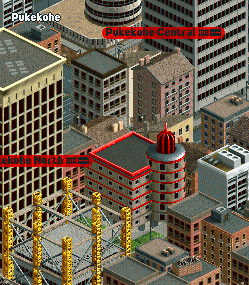
Jaguars! fucked around with this message at 21:15 on Mar 25, 2016 |
|
|
|
Jaguars! posted:Now you've got me wondering whether a modern turbofan engine would work at supersonic speeds too... Work? Yes Work efficiently? Compared to turbojet engines, they're better up until Mach 1.6, at which point they drop off drastically. Afterburners help, though.   Spaced God fucked around with this message at 21:26 on Mar 25, 2016 |
|
|
|
Wow, I'm surprised at how transport capacity has teched up. Enough to actually run a producer out of resources. Now, does that mean it's absolutely going to grow, or is that still kind of random?
|
|
|
|
It's quite possible to do it early on, but it's quite rare for it to happen with trucks, as most industries put out at least 200 tons/month. Our universal rail network hasn't really been efficient enough to do it, you need space for the next vehicle to queue outside the station. Well serviced stations are somewhat more likely to grow. Since we're almost done, I'm going to do another quick scenario to show how to really rake in the cash by exploiting one simple factor that we haven't really been able to take advantage of in our current one. In fact, I was working on it this morning when the game had a memory access violation and crashed. (That was very annoying, this game hardly ever encounters errors IME.)
|
|
|
|
1980-1985: Sloggers and Sprinters Locomotion Soundtrack - Smooth Running/Locomotion Soundtrack - Traffic Jam Click here to name a vehicle!  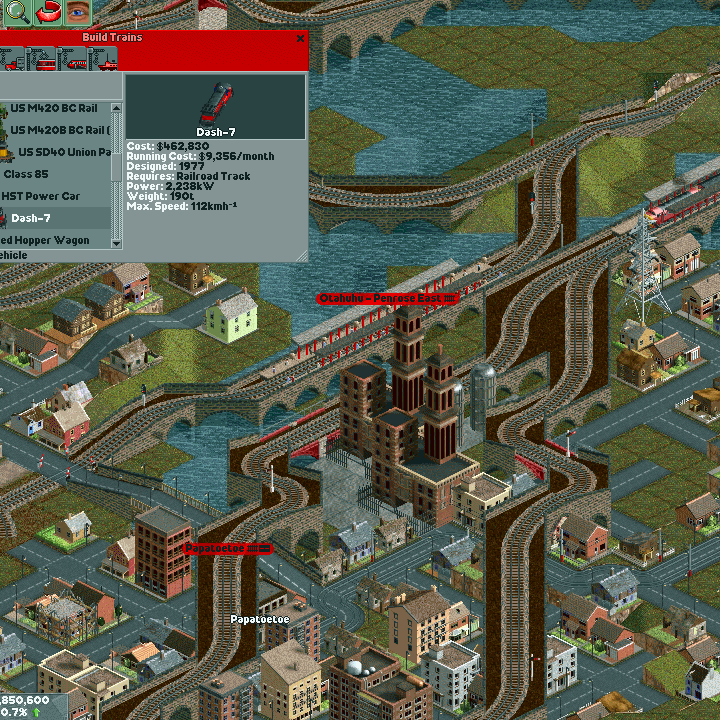 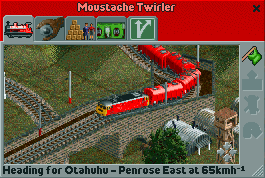 Perhaps it's just Scrooge getting old, but these days we spend most of our time running the company instead of breaking new ground. Even Burgundy doesn't seem to be doing all that much. Nevertheless, we do connect a new rail service from Clevedon farms to the Papatoetoe brewery. After all, there'd have been no point in saving it if we didn't stand to profit from it, would there?  Almost all of this update is spent replacing old vehicles and updating route manifests. Over here, we take some trucks from the queues at the saturated Bombay grain farm and put them to work on the route on the other side of Tuakau. 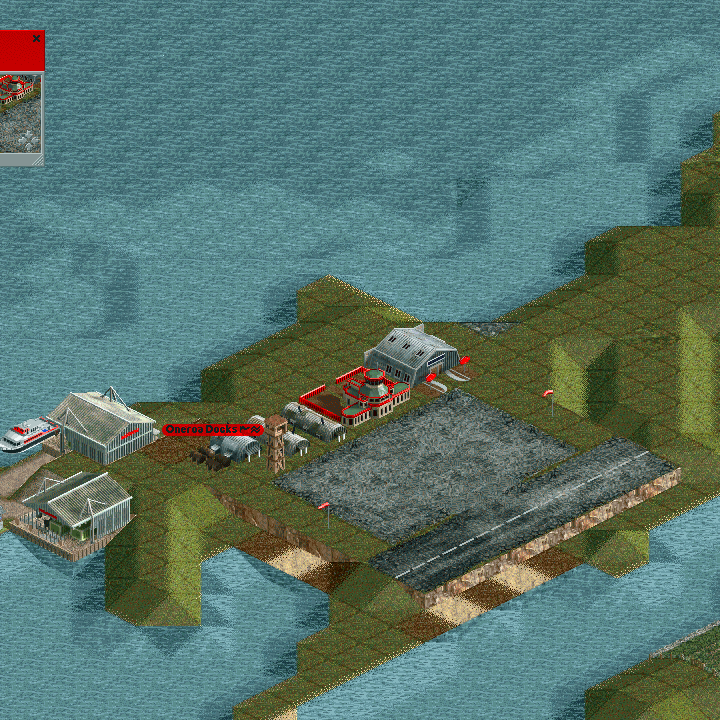  The last two airports are upgraded. These BAE whisperjets cost almost as much as a 737 and only carry 80 people, but this means they can fly more frequently from our low traffic Waiheke Island airport, as they don't sit as long while waiting for passengers. 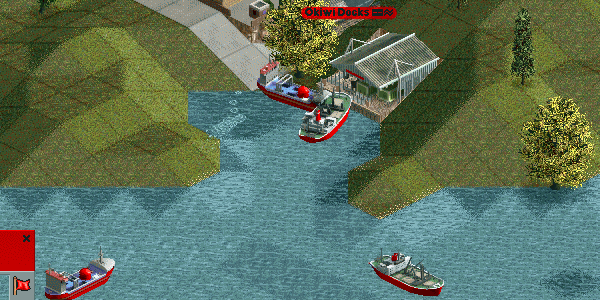 In the Maritime division, everything is well past replacement age. Bulkers and Hovercraft replace general cargo ships, diesel ferries and older hovercraft. I also discover a route that hasn't paid since 1965, when I shifted the docks and failed to update the orders! 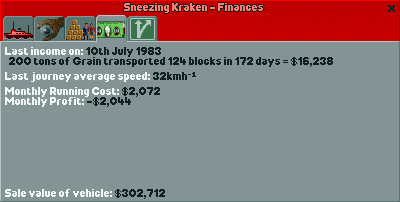 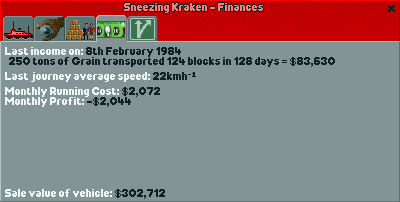 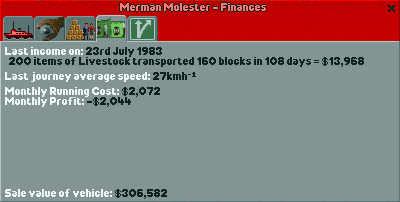 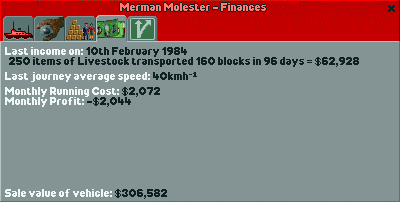 The new ships are 6km/h faster, a big difference when your maximum speed is 50km/h. This makes significant cuts to journey times and therefore profits, as seen in these before/afters.  And it appears we've provoked Evelynn Eggburt into Building a 70km long bridge!   And now it's time for the News! 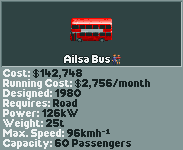 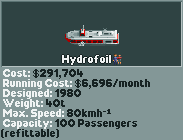 These actually cost more than the Hovercraft to run, while carrying less passengers! we get some all the same. 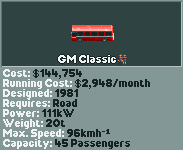 All our buses are replaced with one of the new bus models. Our trams have also been replaced with the 1978 model. 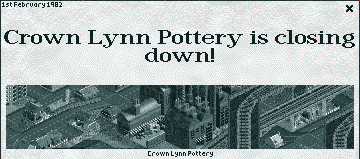 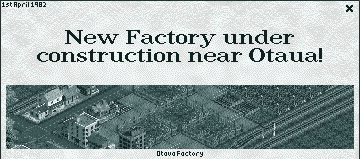 The Factory in New Lynn closes down after decades of neglect, and is replaced by one near our starting point in Otaua. 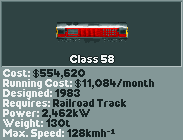   Colour photography hits the newspapers! 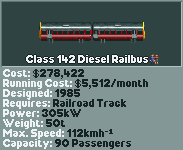 Pity all it has to display is the infamous sprinters. Unfortunately it's just a feature of the late game that there is a constant cycle of replacement and tweaking. The bright side is that things are running better than ever before, and everything more than five years old has been replaced. Hopefully this gives us some breathing room to try new ideas before the game concludes, especially as so many names remain unclaimed!
|
|
|
|
Holy poo poo, that's a hideous loving bridge. Clearly we need to beat her at her own game by making the longest possible bridge that we can possibly roll a train across to transport something somewhere.
|
|
|
|
I'm so glad OpenTTD added an auto replacement function. That is just annoying busywork which takes away from the fun of overcomplicated railway tracks.
|
|
|
|
Instead of doing classwork, I’m writing dumb stuff for a thread on a forum. Let’s chat about an aircraft that both revolutionized civil aviation, and is a great engineering case study. Squares need not apply: The De Havilland Comet Back in 1943, the Brits were optimistically already looking forward towards the post-war aerospace industry. They established the Brabazon Committee to figure and flesh out the five type of aircraft England needed postwar. This Committee is super fascinating, and a lot of really cool planes (and monstrosities) came from this committee and I could probably write a post just on this committee alone but you guys have lives. Also think the Comet is the only one in the game anyways. Anyways, the fourth type outlined in the report was one that brought skepticism: a jet powered aircraft capable of carrying 100 people. Moreover, it was suggested it could carry an imperial ton of payload at 350 knots (~640 kph) and have a pressurized cabin. Jets at the time were fairly new, and were known to guzzle fuel, waste money, and catch explode if you looked at it wrong -- AKA great features for an aircraft designed to fly transatlantic carrying very rich people.Sir Geoffrey de Havilland liked the idea (in fact he used his spot on the committee to ensure a jet aircraft was included on the list), and his company was granted a contract to develop a Type IV aircraft in February 1945, except carrying only 24 passengers instead of 100. Appointed to lead the project was chief designer Ronald Bishop of Mosquito fame, who was known for his creative designs. Moreover, despite the untested technology and high cost with little proof of a return on investment (and despite the unusual designs Bishop had), the state-owned airline BOAC ordered 10 Type IV aircraft from de Havilland in December of the same year. 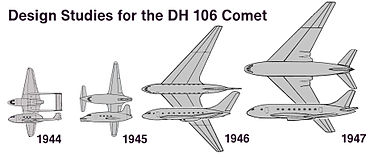 Designs for the Comet. The first two were what made BOAC say “Yes, I want this.”: Over the next year, designs became more and more like the “standard jet aircraft” we know today. 20 degree wingsweep for high speed flights, extra seats added to bring total count to 36, and powered flight controls all make their appearance in their final design. If you look at the above image, though, you’ll notice there are no engine nacelles similar to normal aircraft. The jet engines instead were built into the wing roots, with large intakes at the leading edge. For some reason, British aircraft do this for quite some time and though it looks cool as hell it leads to some strange consequences. Had an engine had one of those explodey moments, you’d lose the wing rather than just the nacelle. Moreover, it required anyone maintenance crews to dig around in the wing rather than simply detach the engine from the nacelle. Anyways, things were tested, pieces were built, and the first Comet prototype made its public appearance at the 1949 Farnborough Airshow (one of the largest airshows in England). The first flight was made in 1950, and a second prototype was built and put through over 500 flight hours for training. More tests, more construction, and finally the first fare flight of a jetliner occurred on from London to Johannesburg on 2 May 1952, carrying three dozen passengers and equal bags of mail. The 5-stop trip took only 21-and-a-half hours. From the start, the aircraft was beloved. Comet flights cut travel time in half compared to the fastest competitors. The jets were quieter than pistons and produced less vibrations, which increased the passenger experience by orders of magnitude. In the first year, 30,000 passengers were carried to various destinations in style, including the first British Royalty to travel by jet when the Queen Mother, Queen Elizabeth, and Princess Margaret traveled via chartered Comet. By the end of 1953, 8 airliners had put orders in for Comets, including three American airlines (Pan-Am, National, and Capital). … And theeeen poo poo went wrong. In January 1954 a BOAC Comet crashed shortly after takeoff from the Italian airport of Ciampino. It had broken up in-flight over the Met with a loss of all souls aboard. There had been some hull losses in the past year, sure, but most were pilot error or easily explainable; every time the aircraft was not at fault. This was different though: there was nothing to indicate a fault. Quoth a de Havilland test pilot: “It was a perfect airplane as far as we were concerned. We were absolutely puzzled by the problems.” Some assumed sabotage, others assumed an engine had failed, taking the rest of the wing with it. All were hoping a cause would be found, and that it was a one-off tragedy. And then it happened again. The scenario was very similar. The aircraft, operating as a South African Airways flight, was examined and preflighted by the same team as the previous mysterious BOAC, and took off on 7 April from London bound for Johannesburg. The stop in Rome was nominal, barring some minor faults. But, after fixing them, the aircraft left en route to Cairo for another refueling stop. The aircraft broke up at 35,000 feet over the Met, and all aboard were killed. Like the BOAC flight, no immediate cause was found. The entire fleet was grounded, and engineers from across the globe threw themselves at the problem to find the root cause of these tragedies. Churchill even famously said “The cost of solving the Comet mystery must be reckoned in neither money nor manpower.” The aerospace industry of England was at stake, and a solution needed to be found fast. Hovercraft are vehicles that can travel over most any terrain using fans or turbines to create a cushion of air upon which the vehicle rides. It’s hard to distinguish when hovercraft first were thought of, because a lot of early thinkers thought of craft more as hydrofoils than hovercraft proper. The difference is that a hovercraft can, as the name implies, hover, whereas a surface effect vehicle requires motion to get ground effect. But, with that being said, in 1929 a Ford engineer named Andrew Kucher started blowing air through a hole in a metal disc. This “Levapad” is considered an ancestor to the modern hovercraft, but it never reached any major use other than a cool demonstration piece. During World War Two Charles Fletcher, an engineer for Bell Laboratories in New Jersey, built a hovercraft the size of a small car named the Glidemobile. Many (including myself) consider it the first hovercraft. It wasn’t patented, however, because the US Government was working on a similar design through a classified project. A man in black’s visit to Fletcher’s door later, and the Glidemobile was locked in a shed for a while. Years later, when a Brit by the name of Cockerell was trying to claim he invented the first hovercraft, Fletcher dusted off his craft to strike down the Brit’s patent. How do I know all about this? Well what I just wrote was more-or-less what I told people as I did tours at the museum I worked at, where Fletcher’s Glidemobile currently resides. The Glidemobile at the Aviation Hall of Fame and Museum of New Jersey. Since this photo was taken, restoration improved the condition of the vehicle. Also, I worked here! ANYWAYS, where was I? After a few weeks, investigators on the Comet Mysteries discovered something about the metal in the fuselage: It showed signs of severe metal fatigue. That didn’t make sense, though. Pre-production testing had shown airframes could last tens of thousands of hours before fatigue would begin to show. The airframes involved only had a few thousand or so hours on the airframe. But then the investigators remembered something important about the jetliner, the fact that it was pressurized. In Italy, autopsies on the passengers had shown injuries consistent with that of an explosive decompression. The investigators began to piece the clues together. No other aircraft had gone through pressurizing cycles as fast and as often as the Comet. That cycle incurred stress on the airframe which weakened it over time. Testing the effects pressurizing cycles had on the airframe concluded that fatigue occurred forty times faster than expected in airframes. A prime suspect was discovered. To double check their findings, investigators put a pressurized Comet fuselage into a tank full of water to simulate spending time at cruising altitude and pressure. 9,000 simulated hours in, a loud bang was heard and the pressures inside the fuselage fell; their theory was confirmed. The tank was drained, and what they saw horrified them. Starting from the window frame, a crack extended to the top of the radio antennas and back along the other side of the fuselage, nearly bisecting the craft with results looking more like a bomb than anything else. Upon further research and calculations, engineers discovered that the strain put against the square windows at the corners were astronomically high, leading to the formation of a crack. From that point on it was clear: Square windows on pressure vessels would not work. Fuselage fragment from the South African incident. Note the square windows and point of fragmentation  The Comets were immediately rebuilt with rounded windows to fix the issue. The first variant of Comet never flew a passenger flight again. Meanwhile across the Pond, Boeing had completed development of its own jetliner, the 707 -- this time with rounded windows. De Havilland had started a jet race, and everyone was pumping out their own jetliners. They competed for a while, with the last Comet flight taking place in March of 1997. They continued to make small jets like the Trident and the Heron, but nothing as innovative as the Comet. For de Havilland, they were gobbled up by Hawker Siddeley in 1960 as a subsidiary until HS went under in 1992. So that’s the story of the de Havilland Comet. It changed the entire landscape of commercial aviation, and brought the world into the jet age. We’re getting into the modern era in game now, so I’m not sure what other aircraft are left to unlock, if any. If y’all have any questions or requests for things I should cover in the remaining time of the LP, just give me a PM or post in the thread. 
|
|
|
|
PurpleXVI posted:Holy poo poo, that's a hideous loving bridge. Clearly we need to beat her at her own game by making the longest possible bridge that we can possibly roll a train across to transport something somewhere. Err... that's pretty much what they've done already. Short of crossing the entire map, that's one of the longer stretches of water in the game. I'm kinda happy that we goaded them into doing that, because I'm sure they wouldn't have done that if we didn't have so many shipping lines out that way. Poil posted:I'm so glad OpenTTD added an auto replacement function. That is just annoying busywork which takes away from the fun of overcomplicated railway tracks.  I wondered what ended up taking so much time, and a lot of it is just looking here and there with no tools active, planning how to get past this, that and the other thing. I also tend to wait for trains and ships to unload their last cargo before replacing them, which also takes time. I wondered what ended up taking so much time, and a lot of it is just looking here and there with no tools active, planning how to get past this, that and the other thing. I also tend to wait for trains and ships to unload their last cargo before replacing them, which also takes time.Spaced God posted:
I like the original design for the Comet. What do we need? A jet airliner. What have we got? The design drawings for the vampire. Can we make this work? Yeah we can give it a go... I wonder, too, if the 707 had to be redesigned based on the comet findings? The Viscount turned out to be a mainstay of or Airline for quite a while, so maybe a little on that would be nice. We do have one or two more aircraft to come out, but they're fairly ordinary airliners.
|
|
|
|
Spaced God posted:So that’s the story of the de Havilland Comet. It changed the entire landscape of commercial aviation, and brought the world into the jet age. We’re getting into the modern era in game now, so I’m not sure what other aircraft are left to unlock, if any. If y’all have any questions or requests for things I should cover in the remaining time of the LP, just give me a PM or post in the thread. I don't have any requests other than, before this is done, find something else you feel is worth talking about. I love me an effortpost. I feel for those poor people who were on the first jets that just... sort of flew apart out from under them in the middle of the sky. At least they died long before they hit the ground?
|
|
|
|
The high speed trains, the TGV, Bullet, etc. Might be interesting. Also the sprinters, since they're infamous apparently!
|
|
|
|
Glazius posted:At least they died long before they hit the ground? Here's where it gets morbid! Depending on the method of decompression, there's between a 15-60 second period of "useful consciousness" at the Comet's cruising altitude. Useful consciousness is determined as how long you're capable of performing flying duties, but it's a good measure for how long a standard person will be self-aware. Explosive decompression usually puts you at the low end of this timeframe, as the air is basically sucked from your lungs by the air rushing from the cabin. Moreover, from last useful breath to brain death is on the order of 4-5 minutes, which is more than the time it takes for you to fall from 36,000 feet. So, unless you were hit by debris and killed by blunt force trauma, you'd not only know you were hosed, but still be alive on the way down. Unconscious, but alive. Morbid tangent, we know this happened during the Challenger disaster. Several spring-loaded switches were moved in what's assumed to be an attempt to restore power to the intact crew capsule, and at least three of the four astronaut emergency air systems that we found were manually activated. If you're into that kinda poo poo, you can find more out here. Which leads me to the only irrational fear I have: knowing you're gonna die in the immediate future and that there's nothing you can do to stop it. As a palette cleanser, have this pug dressed as a slightly larger pug. 
|
|
|
|
Glazius posted:I feel for those poor people who were on the first jets that just... sort of flew apart out from under them in the middle of the sky. At least they died long before they hit the ground? All too often advances in design and safety in all walks of life/industry are paid for in blood. 
|
|
|
|
Veloxyll posted:The high speed trains, the TGV, Bullet, etc. Might be interesting. Also the sprinters, since they're infamous apparently! I found out about the infamous sprinters from Axeman Jim's posts in the PYF obsolete technology thread. They were literally redesigned from buses. Posts: http://forums.somethingawful.com/showthread.php?threadid=3495621&userid=170374 and also some more on poor British Rail decisions here: http://forums.somethingawful.com/showthread.php?threadid=3394711&userid=170374 E: This model of train was known as Pacers. The replacement ones (Which were just as bad) are the sprinters. Jaguars! fucked around with this message at 10:30 on Mar 30, 2016 |
|
|
|
Galaga Galaxian posted:All too often advances in design and safety in all walks of life/industry are paid for in blood.  Quoted article is from the China Economy Thread: quote:China’s MA60 safety record undermines aviation dream
|
|
|
|
Eh, Sprinters are okay. Pacers are awful though. Then again, the class 142 you just unlocked is a Pacer, so in a sense you were right first time  . .
|
|
|
|

|
| # ? Apr 28, 2024 07:07 |
|
Not sure how much it interests people here, but while we're between updates and horrifying safety board post-mortems you may be interested to know the developers behind Train Fever are set to announce their next game on April 11th. No details yet but it will apparently once again feature trains - oddly enough the promo shot on their website features the front profile of a de Havilland Comet. 2016 is shaping up to be the return of weird niche genres. (stop making lovely phone games and get with the program, Sawyer!)
|
|
|







